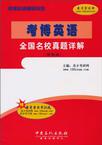考博英语全国名校真题详解
2010-5
中国石化出版社
圣才考研网 编
412
目前我国博士生入学英语考试没有采取全国统考的方式,没有统一的考试大纲,而是采取各招生院校自行命题、自行组织考试的办法,但是各校的考试要求、命题特点大同小异,一些学校的试题类型、内容难易程度都非常相似,因此,研究一些学校的考博试题非常有价值。我们参照一些名校博士生入学英语考试大纲,认真研究了30多所高校200多份历年考博英语真题,精心挑选部分试题和相关资料,编著了考博英语辅导系列。 《考博英语全国名校真题详解》是一本详解全国名校考博英语真题的复习资料。第一版出版后,深受广大读者的欢迎,此次修订收集整理了最新试题(含2008年、2009年)及相关资料,以满足读者需要。它是根据众多名校的英语考试大纲和历年考博试题的结构和难易程度,从全国各个院校历年考博试题中挑选了32个院校最近几年36套考博英语试题,并提供了详细的参考答案。可以说,本书体现了全国名校考博英语的最高水平,也基本反映了各个院校考博英语的出题思路。对于准备参加博士研究生入学考试的考生来说,本书是一本不可多得的辅导资料。
《考博英语全国名校真题详解(第4版)》是全国名校考博英语真题详解的复习资料。它根据众多名校的考博英语大纲和历年考博试题的结构和难易程度,从全国各院校历年考博试题中挑选了32所院校最近几年36套考博英诏试题,并提供详细的参考答案。 圣才学习网/中华英语学习网提供英语类考试名师网络班及面授班(随书配有圣才学习卡,网络班与面授班的详细介绍参见《考博英语全国名校真题详解(第4版)》最后内页)。《考博英语全国名校真题详解(第4版)》和配套网络课程特别适用于参加全国博士英语入学考试的考生,对于参加考研英语、职称英语以及出国考试等其他考试的考生而言,《考博英语全国名校真题详解(第4版)》也具有较好的参考价值。
北京大学2008年博士研究生入学考试试题参考答案及解析清华大学2008年博士研究生入学考试试题参考答案及解析中国人民大学2007年博士研究生入学考试试题参考答案及解析北京师范大学2007年博士研究生入学考试试题参考答案及解析北京师范大学2008年博士研究生入学考试试题参考答案及解析北京航空航天大学2009年博士研究生入学考试试题参考答案及解析北京理工大学2008年博士研究生入学考试试题参考答案及解析对外经济贸易大学2008年博士研究生入学考试试题参考答案及解析首都经贸大学2008年博士研究生入学考试试题参考答案及解析财政部财政科学研究所2009年博士研究生入学考试试题参考答案及解析中国政法大学2006年博士研究生入学考试试题参考答案及解析中国社会科学研究院2007年博士研究生入学考试试题参考答案及解析中国传媒大学2008年博士研究生入学考试试题参考答案及解析复旦大学2008年博士研究生入学考试试题参考答案及解析上海交通大学2008年博士研究生入学考试试题参考答案及解析同济大学2007年博士研究生入学考试试题参考答案及解析同济大学2008年博士研究生入学考试试题参考答案及解析.华东师范大学2008年博士研究生入学考试试题参考答案及解析南京航空航天大学2007年秋博士研究生入学考试试题参考答案及解析南京大学2007年博士研究生入学考试试题参考答案及解析武汉大学2009年博士研究生入学考试试题参考答案及解析华中科技大学2006年春博士研究生入学考试试题参考答案及解析中山大学2003年博士研究生入学考试试题参考答案及解析厦门大学2008年博士研究生入学考试试题参考答案及解析厦门大学2009年博士研究生入学考试试题参考答案及解析东北财经大学2007年博士研究生入学考试试题参考答案及解析东北大学2004年上半年博士研究生入学考试试题参考答案及解析山东大学2004年博士研究生入学考试试题参考答案及解析天津大学2004年博士研究生入学考试试题参考答案及解析南开大学2003年博士研究生入学考试试题.参考答案及解析四川大学2008年博士研究生入学考试试题参考答案及解析四川大学2009年博士研究生入学考试试题参考答案及解析电子科技大学2005年春博士研究生入学考试试题参考答案及解析西南财经大学2007年博士研究生入学考试试题参考答案及解析中国科学技术大学2006年春博士研究生入学考试试题参考答案及解析中国科学院2008年10月博士研究生入学考试试题参考答案及解析
How to do fewer, better animal eperiments For a nation of pet lovers, Britain conducts a surprising number of experiments on animals: some 3m a year. A-merica appears to use fewer animals——just 1. lm a year, according to official statistics——but that is an illusion. Un-like Britain s government, America s does not think rats and mice worth counting. Japan and China have even lesscomprehensive data than America, and animals used in research in those two countries are not protected to the sameextent that they are in the West. Even so, academic centers supporting alternatives to animal testing have emerged inboth places in recent years. In July China issued its first set of guidelines governing the use of animals in research. In an ideal world, there would be no animal testing, it is expensive and can be of dubious scientific value,since different species often react differently to the same procedure. That is why many researchers are working on ways of reducing the number of animal experiments needed and of making those that still happen more effective.However, the transition is proving easier for some types of experiment than for others, as a group of researchers in the field discussed at the sixth World Congress on Alternatives and Animal Use in the Life Sciences, held last week in Tokyo. The most important message from the congress was that things are going in the right direction. The number of animals used in experiments has fallen by half in the past 30 years, at least in those countries that record suchthings. There has also been a shift in the sort of animal used. Most of those employed today are rodents rather than do gs, cats, rabbits and monkeys.(That public opinion generally welcomes this is, however, a good example of"cutist" prejudice for one species over another: there is no reason to believe that rodents suffer less than other mam-mals.)Also, of the experiments that are still conducted, the majority are now concerned with developing and testing medicine rather than, say, checking how toxic cosmetics are. Of the 11 m animals involved each year in experiments that have to be reported to the European Commission, about 45% are used for medical and veterinary purposes and another 35% for basic biomedical research.
